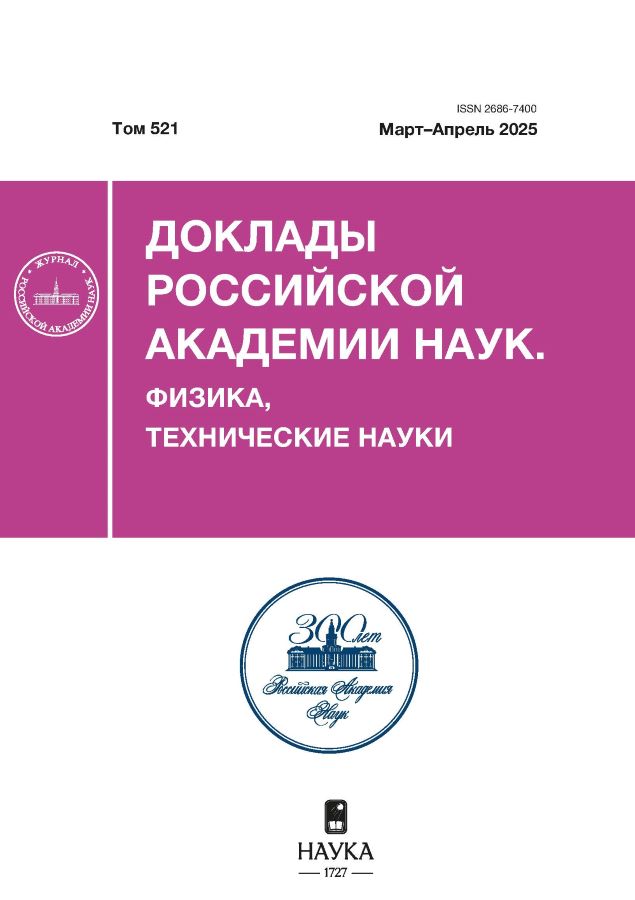Evolution of vortices at the merging of an ethanol droplet with water in an intrusive mode
- Authors: Djoudar B.1, Ilinykh A.Y.2, Chashechkin Y.D.2
-
Affiliations:
- Université des Sciences et de la Technologie d’Oran Mohamed Boudiaf
- Ishlinsky Institute for Problems in Mechanics of the Russian Academy of Sciences
- Issue: Vol 517, No 1 (2024)
- Pages: 18-28
- Section: МЕХАНИКА
- URL: https://permmedjournal.ru/2686-7400/article/view/651771
- DOI: https://doi.org/10.31857/S2686740024040046
- EDN: https://elibrary.ru/JPIUAA
- ID: 651771
Cite item
Abstract
The evolution of vortices formed when a freely falling drop of a 95% aqueous solution of ethanol, tinted with brilliant green, merges with water in the intrusive mode has been traced by method of high-speed video recording. The drop smoothly flows into the liquid and forms a subducting lenticular intrusion, in which a weakly expressed ring vortex is formed if the potential surface energy is greater than or of the same order as its kinetic energy. Gradually, the intrusion of lighter liquid begins to float up and contracts around the cavern, which takes on a conical shape. From the center of the pointed bottom of the cavity, which has reached its maximum depth, a compact volume containing a light liquid of droplet is pushed into the thickness of the liquid. After the cavern collapses, the primary intrusion spreads along the free surface of the target fluid. In this case, the submerging volume is transformed into a small spherical vortex, which reaches its maximum depth, and then stops and forms a compact secondary intrusion elongated vertically. Next, the central part of the secondary intrusion begins to flow up and gradually transforms into a new ring vortex. As it approaches the free surface, the diameter of the vortex increases. The slowly rising shell of the intrusion forms the bottle-shaped base of the cylindrical trace of the ring vortex, colored with droplet pigment. Changes in the sizes of the main structural components during the evolution of the flow pattern were traced.
About the authors
B. Djoudar
Université des Sciences et de la Technologie d’Oran Mohamed Boudiaf
Author for correspondence.
Email: bochra.djoudar@univ-usto.dz
Algeria, Oran
A. Yu. Ilinykh
Ishlinsky Institute for Problems in Mechanics of the Russian Academy of Sciences
Email: ilynykh@ipmnet.ru
Russian Federation, Moscow
Yu. D. Chashechkin
Ishlinsky Institute for Problems in Mechanics of the Russian Academy of Sciences
Email: chakin@ipmnet.ru
Russian Federation, Moscow
References
- Darrigol O. Worlds of flow. A history of hydrodynamics from the Bernoullis to Prandtl. Oxford: University Press. 2005. 356 p.
- Оkabe J., Inoue S. The Generation of Vortex Ring // Kyushu Univ., Rep. Res. Inst. Appl. Mech. 1960. V. 8(32). P. 91–101.
- Бэтчелор Дж. Введение в динамику жидкости. М.: Мир, 1973. 760 с.
- Chapman D.S., Critchlow P. R. Formation of vortex rings from falling drops // J. Fluid Mech. 1967. V. 29(1). P. 177–185. https://doi.org/10.1017/S0022112067000709
- Rodriguez F., Mesler R. The penetration of drop-formed vortex rings into pools of liquid // J. Colloid Interface Sci. 1988. V. 121(1). P. 121–129 https://doi.org/10.1016/0021-9797(88)90414-6
- Cresswell R.W., Morton B.F. Drop-formed vortex rings-The generation of vorticity // Physics of Fluids. 1995. V. 7. P. 1363–1370. https://doi.org/10.1063/1.868524
- Lee J. S., Park S. J., Lee J. H., Weon B. M., Fezzaa K., Je J. H. Origin and dynamics of vortex rings in drop splashing // Nature Commun. 2015. V. 6(1). https://doi.org/10.1038/ncomms9187
- Dooley B., Warncke A., Gharib M. et al. Vortex ring generation due to the coalescence of a water drop at a free surface // Exp. in Fluids. 1997. V. 22. P. 369–374. https://doi.org/10.1007/s003480050062
- Степанова Е.В., Чашечкин Ю.Д. Перенос маркера в составном вихре // Известия РАН. МЖГ. ٢٠١٠. № 6. Р. 12–29.
- Chashechkin Yu.D., Ilinykh A. Y. Intrusive and impact modes of a falling drop coalescence with a target fluid at rest // Axioms. 2023. V. 12(4). P. 374. https://doi.org/10.3390/axioms12040374
- Zhang Y., Mu Z., Wei Y., Jamil H., Yang Y. Evolution of the heavy impacting droplet: Via a vortex ring to a bifurcation flower // Phys. of Fluids. 2021. V. 33. P. 113603. https://doi.org/10.1063/5.0064072
- Gao T.-C., Chen R.-H., Pu J.-Y., Lin T.-H. Collision between an ethanol drop and a water drop. Experiments in Fluids. 2005. V. 38(6). P. 731–738.https://doi.org/10.1007/s00348-005-0952-1
- Thomson W., Tait P.G. A Treatise on Natural Philosophy. Oxford (UK): Clarendon Press, 1867. 727 p.
- Ландау Л.Д., Лифшиц Е.М. Гидродинамика. М.: Наука, 1986. 736 с.
- Feistel R. Thermodynamic properties of seawater, ice and humid air: TEOS-10, before and beyond // Ocean Sciences. 2018. V. 14. P. 471–502. https://doi.org/10.5194/os-14-471-2018
- Harvey A. H., Hrubý J., Meier K. Improved and always improving: reference formulations for thermophysical properties of water // J. of Phys. and Chem. Ref. Data. 2023. V. 52. P. 011501. https://doi.org/10.1063/5.0125524.
- Найфэ А. Введение в методы возмущений. М.: Мир, 1984. 532 с.
- Chashechkin Y.D. Foundations of engineering mathematics applied for fluid flows // Axioms. 2021. V. 10(4). P. 286. https://doi.org/10.3390/axioms10040286
- УИУ “ГФК ИПМех РАН”: Гидрофизический комплекс для моделирования гидродинамических процессов в окружающей среде и их воздействия на подводные технические объекты, а также распространения примесей в океане и атмосфере. Сайт: http://www.ipmnet.ru/uniqequip/gfk/#equip.
- Чашечкин Ю.Д., Ильиных А.Ю. Задержка формирования каверны в интрузивном режиме слияния свободно падающей капли с принимающей жидкостью // Доклады РАН. Физика, технические науки. 2021. Т. 496. C. 34–39. https://doi.org/10.31857/S268674002101003X
Supplementary files










